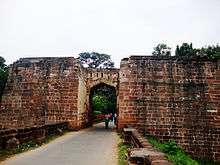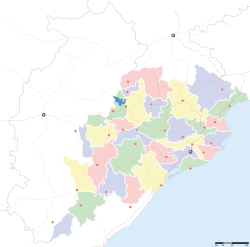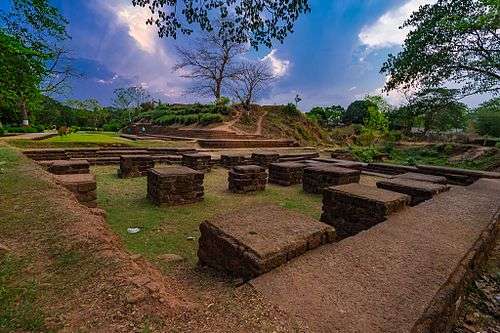Barabati fort
 Entrance of Barabati Fort | |
 Barabati Fort | |
| Coordinates | 20°29′4.67″N 85°51′51.93″E / 20.4846306°N 85.8644250°ECoordinates: 20°29′4.67″N 85°51′51.93″E / 20.4846306°N 85.8644250°E |
|---|---|
| Beginning date | 989 A.D. |
| Dedicated to | King Nrupa Keshari |

Barabati Fort is a 14th-century fort built by the Ganga dynasty near Cuttack, Odisha. The ruins of the fort remain with its moat, gate, and the earthen mound of the nine-storied palace, which evokes the memories of past days. Today it sits next to the modern Barabati Stadium, the venue of various sport events and cultural programs. There is also a temple dedicated to Katak Chandi, the presiding deity of the city, not far away from the fort. Now there are plans to develop the old Gadakhai into a world class tourist destination with boating facilities and a world class park. The renovation work of the Gadakhai is going on in full swing.
Location
This medieval fort is situated at 20°29′1.32″N 85°52′3.36″E / 20.4837000°N 85.8676000°E, about 8 km away from the center of the Cuttack, at the apex of a delta formed by the river Mahanadi on the north and its distributary, the Kathajodi on the south, and is located at 14.62 metres above sea level.
History
Scholars give different opinions regarding the date of construction of Barabati fort. Madalapanji, the Jagannatha temple chronicle narrate an interesting story which is as follows.
King Bhima Parichha or Anangabhima II lived in his capital, Chaudwar. One day the king crossed the Mahanadi and came towards the southern side. Here he noticed in the Barabati village belonging to the Ko-danda sub-division that near the god Visweswar Deva, a heron had jumped upon a hawk. Seeing this the king was very much surprised and on an auspicious day laid the foundation of construction of the fort and this village was named Barabati Cuttack. And after that he left Choudwar and lived at Cuttack making it his capital.
In the opinion of Jagabandhu Singh, Anangabhima Deva II ruled for 27 years (1183-1210 AD) and in the 12th year of his reign Barabati was constructed. This fort was constructed by Anangabhima Deva (1189-1223 AD) in the 13th year of his reign i.e., in 1202 AD. The newly discovered Nagari cooper plate issued by Anangabhima Deva donated land from Varanasi Kataka. On the basis of this evidence K.C. Panigrahi concludes that Barabati fort was constructed sometime after 1223 AD. Thus the fort was built after 1229 AD and before 1238 AD Barabati fort witnessed the fortunes and the fall of the long line of Ganga and Suryavamsi rules. During the rule of the Muslims and the Marathas it continued to be the capital of Odisha. The British army took possession of Barabati fort on October 1803, and it became a prison for confinement of several illustrious rulers of the land. In 1800 the Raja of Kujanga, in 1818 the Raja of Surgaja with his family members were kept under strict confinement to this fort. In addition vandalism to destroy the fort was intensified in the early phase of British rule.
Excavation by Archaeological survey of India on 1 December 1989 revealed evidence of a palace, a square structure built up of khondalite stone. It was built over an area which was carefully prepared by filling in 5 meters with sand and Malba. Trenches taken on the eastern side of the structure revealed 32 pillars built of laterite blocks roughly square but varying in size. In the northeastern corner of the mound remains of a temple have been found. Excavation on the eastern and southern side of the mound revealed the existence of a citadel wall built of laterite blocks.[1] In 1568 AD, the city passed to the hands of Afghan rulers of Bengal, then to the Moghul Empire in 1592 and the Marathas in 1751. Cuttack, with the rest of Odisha, came under British rule in 1803. The Bengal-Nagpur Railways connected Cuttack with Madras (Chennai) and Calcutta (Kolkata) in 1919. It became the capital of the newly formed state of Odisha in 1936 and continued to be so till 1948 when the capital was shifted to Bhubaneswar. The city completed one thousand years of its existence in 1989.

The ruins of the old Barabati Fort lie on the right bank of the Mahanadi, in the western part of the city. All that remains of the Fort is an arched gateway and the earthen mound of the nine-storeyed palace. Archaeological surveys reveal that the Fort was roughly rectangular in structure having an area of over 102 acres (0.41 km2), and it was surrounded on all sides by a wall of laterite and sandstones. To the west of the mound there is a tank. In the north-eastern corner of the mound are remains of what once was a temple. The temple was made of whitish sandstone over foundations of laterite blocks. About four hundred fragments of mouldings and some mutilated pieces of sculptures have been recovered so far. This temple of the Ganga period containing a stone idol of Lord Jagannath is in ruins. A mosque built by Nawab Murshid Quli Khan, governor of Emperor Aurangzeb in 1719 AD still exists.
References
- ↑ OHRJ, Vol. XLVII, No. 2, Utkal University 18 April 2016